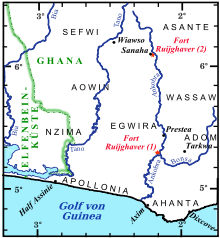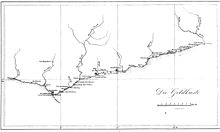Fort Ruijghaver
Fort Ruijghaver (mostly referred to as Fort Ruychaver in English-language literature ) was a Dutch trading post in the hinterland of the western Gold Coast in present-day Ghana , which existed on the Ankobra River between 1654 and 1660 .
The name of the branch goes back to Jacob Ruijghaver , the general director of the Dutch West India Company (WIC) on the Gold Coast, who initiated the establishment of this branch.
The purpose of the trading post was to trade gold , since it was built in an area that was traditionally considered one of the centers of gold production.
The classification of the settlement as a fort is, however, an invention from modern literature, because there could be no question of a fortified military protective system in the sense of a smaller fortress. The branch consisted only of a house (lodge or lodge) plus a few smaller huts.
Fort location
There are different opinions in the literature about the exact location of the fort, as the map is intended to illustrate.
One thesis assumes that Fort Ruijghaver was located on the right bank of the Ankobra directly opposite the mouth of the Bonsa River in the Egwira region, as illustrated by a map reproduced by Doormann.
The other thesis, which is mainly supported by Daaku, takes as its starting point an entry in the diary of the then General Manager Valckenburg, which describes Fort Ruijghaver at a distance of 30 miles from the coast on the Ankobra River. At that time, 1 Amsterdam mile represented 5,754.53 m, so 30 miles corresponded to a distance of almost 173 km. In fact, at this distance (as the crow flies) on the Ankobra River is the town of Sanaha (Sanaya), where the fort is said to have been according to Daaku.
There are extensive gold fields at both locations, which were considered centers of gold production even in the pre-colonial times. But it does not seem credible that the Dutch are said to have crossed the gold fields of the Prestea / Tarkwa region at that time in order to develop other, far more northerly located gold centers as sources of trade.
History of the branch
The history of the branch was as dramatic as it was short-lived.
A French branch had previously been located at the same location (or near it).
Although defeats and losses had to be accepted in numerous places in West Africa, the Dutch had managed to establish a secure and powerful presence , at least in Axim . With Axim as the starting point, efforts were therefore made to expand Dutch influence further inland in order to gain better access to the gold sources.
However, it was not very successful, which was not least due to the local resistance to a permanent Dutch presence. Nevertheless, the trade envy towards the French competition already established in the Egwira region seems to have been excessive among the Dutch, so that the decision was made in 1654 to attack the French trading post on the Ankobra River despite the state of peace between France and the Netherlands in Europe and to occupy by force.
Although the local native population was initially hostile to the Dutch to a certain extent, they eventually succeeded in gaining permanent residence and trade rights. The Dutch then tried to cement the current state of tolerance and put it on a peaceful basis. For this purpose, local salt traders from Axim were invited to settle in the immediate vicinity of Fort Ruijghaver, as the branch was now called, in order to do business with the Egwira people.
Despite a certain general opposition attitude of the local population towards the Dutch, it remained peaceful at first, but this situation did not last long. In 1659 it was noted in Axim that all communication and transport routes to Fort Ruijghaver were interrupted and that they had no knowledge of what events had led to such hostility among the Egwiras. At the beginning of 1660 the news was finally received that the entire settlement had been destroyed and that the Axim salt traders had been driven out again. The Dutch company on the Ankobra River had failed.
This failure was primarily the result of the tactlessness of the local Dutch sub-factor, a man by the name of de Liefde, who had additionally reinforced an already existing general opposition and ultimately brought about the catastrophe.
De Liefde had made a deal with an Adom chief named Jantecona. He died, however, and at the time of his death he left de Liefde owed about 12 ounces of gold in the currency of the time. In order to collect this debt, de Liefde had a wife of the deceased kidnapped along with one of his children ("panjarren" in the linguistic usage at the time). This meant that the widow and child were held hostage with him until the debt was cleared.
In itself, this would have been perfectly legitimate in the local understanding of law at the time, had it not been for de Liefde already having two other hostages in custody. In the eyes of the locals, he had committed a clear breach of the law, because he would have had to wait either until the previous hostages had been released, or if the matter with the Jantecona family was more important to him must release. However, de Liefde had not done this. The hostages' two families were deeply offended and demanded satisfaction, but de Liefde only punished them with contempt and treated them accordingly.
De Liefde went so far as to refuse to hear Corre Chary (Kore Kyere), an influential Egwira chief, about an intercession in favor of the hostages. So it came as it had to come. An Adom army under the command of a boubou advanced and began to besiege the settlement. De Liefde could not expect any support from the locals, on the contrary, many of them openly support the Adom warriors with food and the like. a. and some also took part in driving out the Axim salt merchants who had settled in the Netherlands.
In view of the hopeless situation, de Liefde finally set fire to his powder chamber and blew himself up with the entire building.
The Dutch did not attempt to revive their trading post or gain a foothold elsewhere in Egwira Land. In the period that followed, the focus was more on maintaining or expanding one's own position of power in and around Axim.
Footnotes
- ↑ This is where today's second largest gold mine in the world is located.
- ↑ The landscape east of Egwira and north of Ahanta.
swell
- Henry Meredith: An Account of the Gold Coast of Africa: with a brief history of the African Company , London 1812
- Brodie Cruickshank: An eighteen-year stay on the gold coast of Africa , Leipzig 1855
- JG Doorman: The Dutch-West-Indian Compagnie on the Gold Coast , In: Tijdschrift voor Indische Taal-, Land- en Volkenkunde (Batavia), 40 (5/6), 1898, pp. 387–496
- Kwame Yeboa Daaku: Trade and politics on the Gold Coast 1600-1720 - A Study of the African Reaction to European Trade , Oxford, 1970

